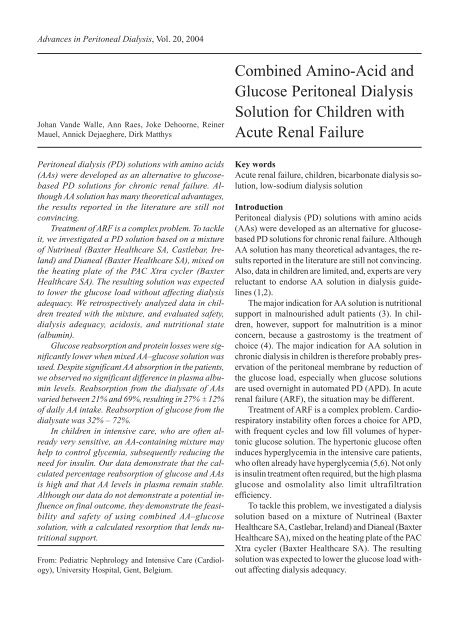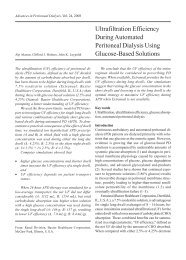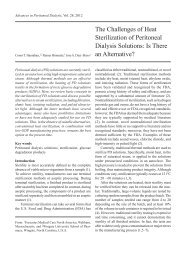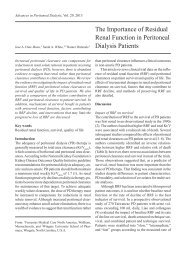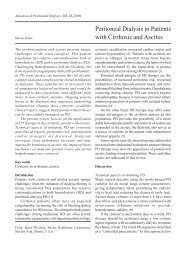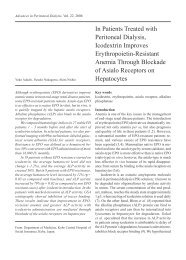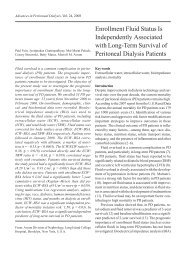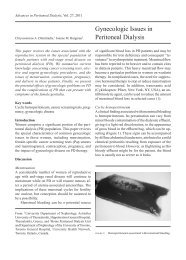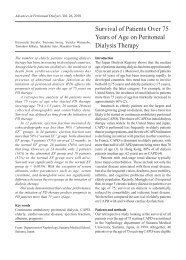Combined Amino-Acid and Glucose Peritoneal Dialysis Solution for ...
Combined Amino-Acid and Glucose Peritoneal Dialysis Solution for ...
Combined Amino-Acid and Glucose Peritoneal Dialysis Solution for ...
- No tags were found...
Create successful ePaper yourself
Turn your PDF publications into a flip-book with our unique Google optimized e-Paper software.
Advances in <strong>Peritoneal</strong> <strong>Dialysis</strong>, Vol. 20, 2004Johan V<strong>and</strong>e Walle, Ann Raes, Joke Dehoorne, ReinerMauel, Annick Dejaeghere, Dirk Matthys<strong>Combined</strong> <strong>Amino</strong>-<strong>Acid</strong> <strong>and</strong><strong>Glucose</strong> <strong>Peritoneal</strong> <strong>Dialysis</strong><strong>Solution</strong> <strong>for</strong> Children withAcute Renal Failure<strong>Peritoneal</strong> dialysis (PD) solutions with amino acids(AAs) were developed as an alternative to glucosebasedPD solutions <strong>for</strong> chronic renal failure. AlthoughAA solution has many theoretical advantages,the results reported in the literature are still notconvincing.Treatment of ARF is a complex problem. To tackleit, we investigated a PD solution based on a mixtureof Nutrineal (Baxter Healthcare SA, Castlebar, Irel<strong>and</strong>)<strong>and</strong> Dianeal (Baxter Healthcare SA), mixed onthe heating plate of the PAC Xtra cycler (BaxterHealthcare SA). The resulting solution was expectedto lower the glucose load without affecting dialysisadequacy. We retrospectively analyzed data in childrentreated with the mixture, <strong>and</strong> evaluated safety,dialysis adequacy, acidosis, <strong>and</strong> nutritional state(albumin).<strong>Glucose</strong> reabsorption <strong>and</strong> protein losses were significantlylower when mixed AA–glucose solution wasused. Despite significant AA absorption in the patients,we observed no significant difference in plasma albuminlevels. Reabsorption from the dialysate of AAsvaried between 21% <strong>and</strong> 69%, resulting in 27% ± 12%of daily AA intake. Reabsorption of glucose from thedialysate was 32% – 72%.In children in intensive care, who are often alreadyvery sensitive, an AA-containing mixture mayhelp to control glycemia, subsequently reducing theneed <strong>for</strong> insulin. Our data demonstrate that the calculatedpercentage reabsorption of glucose <strong>and</strong> AAsis high <strong>and</strong> that AA levels in plasma remain stable.Although our data do not demonstrate a potential influenceon final outcome, they demonstrate the feasibility<strong>and</strong> safety of using combined AA–glucosesolution, with a calculated resorption that lends nutritionalsupport.From: Pediatric Nephrology <strong>and</strong> Intensive Care (Cardiology),University Hospital, Gent, Belgium.Key wordsAcute renal failure, children, bicarbonate dialysis solution,low-sodium dialysis solutionIntroduction<strong>Peritoneal</strong> dialysis (PD) solutions with amino acids(AAs) were developed as an alternative <strong>for</strong> glucosebasedPD solutions <strong>for</strong> chronic renal failure. AlthoughAA solution has many theoretical advantages, the resultsreported in the literature are still not convincing.Also, data in children are limited, <strong>and</strong>, experts are veryreluctant to endorse AA solution in dialysis guidelines(1,2).The major indication <strong>for</strong> AA solution is nutritionalsupport in malnourished adult patients (3). In children,however, support <strong>for</strong> malnutrition is a minorconcern, because a gastrostomy is the treatment ofchoice (4). The major indication <strong>for</strong> AA solution inchronic dialysis in children is there<strong>for</strong>e probably preservationof the peritoneal membrane by reduction ofthe glucose load, especially when glucose solutionsare used overnight in automated PD (APD). In acuterenal failure (ARF), the situation may be different.Treatment of ARF is a complex problem. Cardiorespiratoryinstability often <strong>for</strong>ces a choice <strong>for</strong> APD,with frequent cycles <strong>and</strong> low fill volumes of hypertonicglucose solution. The hypertonic glucose ofteninduces hyperglycemia in the intensive care patients,who often already have hyperglycemia (5,6). Not onlyis insulin treatment often required, but the high plasmaglucose <strong>and</strong> osmolality also limit ultrafiltrationefficiency.To tackle this problem, we investigated a dialysissolution based on a mixture of Nutrineal (BaxterHealthcare SA, Castlebar, Irel<strong>and</strong>) <strong>and</strong> Dianeal (BaxterHealthcare SA), mixed on the heating plate of the PACXtra cycler (Baxter Healthcare SA). The resultingsolution was expected to lower the glucose load withoutaffecting dialysis adequacy.
V<strong>and</strong>e Walle et al.Patients <strong>and</strong> methodsWe retrospectively analyzed data in children treatedwith an AA-based PD solution (Nutrineal) mixed withDianeal in a cycler. We evaluated safety, dialysis adequacy,acidosis, <strong>and</strong> nutritional state (albumin). Weper<strong>for</strong>med an AA analysis to evaluate whether the socalledNO-related AAs were increased in plasma,which could possibly lead to risk of shock <strong>and</strong>vasodilatation.The study group consisted of 33 patients who weretreated <strong>for</strong> ARF <strong>for</strong> at least 72 hours at our hospitalduring the period 1993 – 2000. The cycler was programmed<strong>for</strong> cycles of 10 minutes inflow, 100 minutesdwell time, <strong>and</strong> 10 minutes outflow. <strong>Glucose</strong>solution was used <strong>for</strong> the first 48 hours. From 48 hoursto 72 hours, the solution combined 1 bag of Nutrineal1.1% <strong>and</strong> 1 bag of Dianeal 3.86%.We measured the dialysate <strong>and</strong> plasma AA concentrations(Figure 1), the plasma AA concentrationsbe<strong>for</strong>e <strong>and</strong> after Nutrineal (Figure 2), <strong>and</strong> dialysateparameters. We calculated peritoneal reabsorption(glucose <strong>and</strong> AAs) <strong>and</strong> determined blood urea nitrogen(BUN), creatinine, serum albumin, body parameters,<strong>and</strong> dialysis adequacy.227ResultsWe observed no significant differences in plasmacreatinine, BUN, acidosis, or ultrafiltration rate be<strong>for</strong>e<strong>and</strong> after use of Nutrineal. <strong>Glucose</strong> reabsorption<strong>and</strong> protein losses were significantly lower whenmixed AA–glucose solution was used. Despite significantAA absorption, we observed no significantdifference in plasma albumin levels. Reabsorptionfrom the dialysate of AAs varied between 21% <strong>and</strong>69%, resulting in 27% ± 12% of daily AA intake.Reabsorption of glucose from the dialysate was 32% –72%.Figure 1 shows that the relative concentrationsof several AAs were different in dialysate <strong>and</strong> plasma.The large st<strong>and</strong>ard deviations <strong>for</strong> the measured dialysateconcentrations may be surprising, but theydo not suggest a manufacturing problem. Rather, theyare related to the different size <strong>and</strong> <strong>for</strong>mat of theNutrineal <strong>and</strong> Dianeal bags, which produce a slightdisequilibrium as the 2 bags pump up to the heatingplate.Figure 2 shows that, after 48 – 72 hours, plasmaAA levels were not significantly changed (especiallyarginine concentration).FIGURE 1Dialysate <strong>and</strong> plasma levels of amino acids (AA) <strong>for</strong> the study patients.
228Combination PD <strong>Solution</strong> in Children with ARFFIGURE 2 Plasma levels of free amino acids (AA) <strong>for</strong> the study patients be<strong>for</strong>e <strong>and</strong> after treatment with combined amino-acid <strong>and</strong>glucose dialysis solution.DiscussionThe introduction of APD into clinical practice in anintensive care unit raises several metabolic problems<strong>and</strong> affects the nutrition status <strong>and</strong> the acid, electrolyte,<strong>and</strong> fluid balance of the patients (7). The optionof continuous renal replacement therapy there<strong>for</strong>e offersthe ability to ultrafilter <strong>and</strong> to dialyze to the desiredlevel <strong>and</strong> to deliver high nutritional support(1,8–10). But what is often <strong>for</strong>gotten is that more ultrafiltrationrequires more substitution <strong>and</strong> that “more”has not always been proven to be “better.” There maybe a place to optimize softer types of renal replacementtherapy such as PD. The present study demonstratesthat modifying conventional PD may result insignificant nutritional support, better metabolic homeostasis,<strong>and</strong> fewer side effects (hyperglycemia, need<strong>for</strong> insulin).The possibility of using PD itself as a source ofnutrients in the treatment of malnutrition is an intriguingconcept (11). Un<strong>for</strong>tunately, it is not possible toproduce dialysis solution that contains both glucose<strong>and</strong> AAs because of technical problems of preservation(such as crystallization <strong>and</strong> caramelization) unlessa multiple-compartment system such as that currentlyused <strong>for</strong> bicarbonate-buffered solution is developed.Hence, the simultaneous infusion of glucose<strong>and</strong> AAs is not possible in continuous ambulatory PDin adults (11,12). Automated PD (APD), which isbased on the use of a cycler, permits different solutionsto be simultaneously pumped from reservoir bagsinto an empty bag on the heating plate, thereby producinga reasonably homogeneous mixture. In theory,1 glucose bag can be mixed with 1 AA bag to obtain50% of each, or 2 glucose bags could be mixed with1 AA bag <strong>for</strong> patients who need a reduced AA load.Various options are possible.In APD, a combined AA <strong>and</strong> glucose solutionrather than the traditional single daily bag of Nutrinealis potentially superior <strong>for</strong> reaching anabolic goals, <strong>for</strong>these reasons:• An optimal anabolic effect requires AAs <strong>and</strong> glucoseto be delivered together.• Large glucose-induced changes in insulin areavoided.• Loss of AAs in glucose dwells (3 of 4) is avoided.
V<strong>and</strong>e Walle et al.229Soon after the introduction of Nutrineal, thosetheoretical considerations were already documentedin clinical practice. Indeed, in almost all of the studieson the use of intraperitoneal AAs, a significantincrease in serum levels of urea were reported, suggestingunsatisfactory utilization of the infused AAs(11,12). Moreover, it is well known that, without anenergy source, nitrogen will not be effectively incorporatedinto proteins.In parenteral nutrition, the combined infusion ofnon protein calories <strong>and</strong> AAs has been a key factorin ensuring the optimal utilization of the AAs. Totalparenteral nutrition (TPN) solutions with a ratio of150:1 (non protein calories to nitrogen) are consideredappropriate <strong>for</strong> most patients to incorporate deliveredAAs into new proteins. A mixture of Nutrineal<strong>and</strong> Dianeal simultaneously achieves three conditionsfavorable <strong>for</strong> protein synthesis: hyperinsulinemia,hyperaminoacidemia, <strong>and</strong> an adequate ratio of nonprotein calories to nitrogen (absorbed glucose toAAs).These considerations are of even more importancein intensive care units, where most patients are catabolic,lack enteral nutrition, <strong>and</strong> require ultrafiltration<strong>for</strong> every parenteral milliliter administered. The useof combined glucose–AA solutions in a peritoneumwith hyperemic dilated vessels will result in significantperitoneal resorption. That resorption may meeta significant percentage of the patient’s nutritionalneeds (AAs <strong>and</strong> glucose), limiting the need <strong>for</strong> intravenousadministration of TPN. Limiting intravenousfluid administration helps to eliminate the need <strong>for</strong>ultrafiltration by dialysis.In children in intensive care, who are often alreadyvery sensitive, an AA-containing mixture may helpto control glycemia, subsequently reducing the need<strong>for</strong> insulin. Our data demonstrate that the calculatedpercentage reabsorption of glucose <strong>and</strong> AAs is high<strong>and</strong> that plasma AA levels remain stable. The reabsorptiondata are comparable with data reported byCanepa et al. <strong>and</strong> Qamar et al. (13–17).Adequate protein <strong>and</strong> energy intake are essentialto the maintenance of nitrogen balance <strong>and</strong> the preventionof malnutrition in intensive care. Treatmentwith oral calorie <strong>and</strong> protein supplements is oftenimpossible, but intravenous administration of TPN isoften limited by the excessive fluid load imposed on apatient in anuria by the need to reach a given nutritionaltarget. The use of AA-based dialysis fluid combinedwith glucose may provide opportunities to compensate<strong>for</strong> dialytic losses of protein <strong>and</strong> AAs <strong>and</strong> tosupplement inadequate dietary protein intake, withsubsequent improvement in nutritional status, becauseof the resulting anabolic benefit <strong>and</strong> limitation of unnecessaryAA metabolism.ConclusionsAlthough our data do not demonstrate a potential influenceon final outcome, they demonstrate the feasibility<strong>and</strong> safety of using combined AA–glucosesolution, with a calculated resorption that lends nutritionalsupport.References1 Strazdins V, Watson AR, Harvey AR. Renal replacementtherapy <strong>for</strong> acute renal failure in children: Europeanguidelines. Pediatr Nephrol 2004; 19:199–207.2 Schroder CH <strong>and</strong> the European Paediatric <strong>Peritoneal</strong><strong>Dialysis</strong> Working Group. The choice of dialysis solutionsin pediatric chronic peritoneal dialysis: guidelinesby an ad hoc European committee. Perit Dial Int2001; 21:568–74.3 Kopple JD, Bernard D, Messana J, et al. Treatment ofmalnourished CAPD patients with an amino acidbased dialysate. Kidney Int 1995; 47:1148–57.4 Coleman JE, Watson AR, Rance CH, Moore E. Gastrostomybuttons <strong>for</strong> nutritional support on chronicdialysis. Nephrol Dial Transplant 1998; 13:2041–6.5 Flynn JT, Kershaw DB, Smoyer WE, Brophy PD,McBryde KD, Bunchman TE. <strong>Peritoneal</strong> dialysis <strong>for</strong>management of pediatric acute renal failure. PeritDial Int 2001; 21:390–4.6 V<strong>and</strong>e Walle J, Raes A, Castillo D, Lutz–Dettinger N,Dejaegher A. New perspectives <strong>for</strong> PD in acute renalfailure related to new catheter techniques <strong>and</strong> introductionof APD. Adv Perit Dial 1997; 13:190–4.7 V<strong>and</strong>e Walle J, Raes A, Castillo D, Lutz–Dettinger N,Dejaegher A. Advantages of HCO 3solution with lowsodium concentration over st<strong>and</strong>ard lactate solutions<strong>for</strong> acute peritoneal dialysis. Adv Perit Dial 1997; 13:179–82.8 Goldstein SL. Overview of pediatric renal replacementtherapy in acute renal failure. Artif Organs2003; 27:781–5.9 Maxvold NJ, Smoyer WE, Gardner JJ, BunchmanTE. Management of acute renal failure in the pediatricpatient: hemofiltration versus hemodialysis. Am JKidney Dis 1997; 30(Suppl 4):S84–8.10 Symons JM, Brophy PD, Gregory MJ, et al. Continuousrenal replacement therapy in children up to10 kg. Am J Kidney Dis 2003; 41:984–9.
23011 Park MS, Heimbürger O, Bergström J, Waniewski J,Werynski A, Lindholm B. <strong>Peritoneal</strong> transport duringdialysis with amino acid–based solutions. Perit DialInt 1993; 13:280–8.12 Dombros NV, Prutis K, Tong M, et al. Six-monthovernight intraperitoneal amino-acid infusion in continuousambulatory peritoneal dialysis (CAPD) patients—noeffect on nutritional status. Perit Dial Int1990; 10:79–84.13 Canepa A, Carrea A, Menoni S, et al. Acute effectsof simultaneous intraperitoneal infusion of glucose<strong>and</strong> amino acids. Kidney Int 2001; 59:1967–73.14 Canepa A, Perfumo F, Carrea A, et al. Long-term effectof amino-acid dialysis solution in children oncontinuous ambulatory peritoneal dialysis. PediatrNephrol 1991; 5:215–19.15 Canepa A, Perfumo F, Carrea A, et al. ContinuousCombination PD <strong>Solution</strong> in Children with ARFambulatory peritoneal dialysis (CAPD) of childrenwith amino acid solutions: technical <strong>and</strong> metabolicaspects. Perit Dial Int 1990; 10:215–20.16 Qamar IU, Secker D, Levin L, Balfe JA, Zlotkin S,Balfe JW. Effects of amino acid dialysis compared todextrose dialysis in children on continuous cyclingperitoneal dialysis. Perit Dial Int 1999; 19:237–47.17 Canepa A, Filho JC, Gutierrez A, et al. Free aminoacids in plasma, red blood cells, polymorphonuclearleukocytes, <strong>and</strong> muscle in normal <strong>and</strong> uraemic children.Nephrol Dial Transplant 2002; 17:413–21.Corresponding author:Johan V<strong>and</strong>e Walle, MD, Renal Unit, University Hospital,185 De Pintelaan, B-9000 Gent, Belgium.E-mail:Johan.V<strong>and</strong>eWalle@Ugent.be
Advances in <strong>Peritoneal</strong> <strong>Dialysis</strong>, Vol. 20, 2004Marta A. Azocar, 1 Francisco J. Cano, 1 Verónica Marin, 2Maria A. Delucchi, 1 Eugenio E. Rodriguez 1Body Composition inChildren on <strong>Peritoneal</strong><strong>Dialysis</strong>Dual-energy X-ray absorptiometry (DEXA) can beused to evaluate total-body bone mineral content(BMC), bone mineral density (BMD), fat-free mass(FFM), <strong>and</strong> fat body mass (FBM), which are all frequentlyaffected in patients (PD) on peritoneal dialysis.We used DEXA to evaluate body composition inchildren on PD <strong>and</strong> to establish whether relationshipsexisted with nutrition status, dialytic parameters, <strong>and</strong>biochemical data.We evaluated 20 PD patients (12 boys, 8 girls).The mean age of the patients was 5.84 years (range:0.16 – 14.66 years). We carried out DEXA, anthropometry(weight/age, height/age, <strong>and</strong> body massindex), <strong>and</strong> measurements of dietary intake (protein,energy, calcium, <strong>and</strong> phosphorus), nitrogen balance(NB), dialysis dose (Kt/V), peritoneal equilibrium test(PET), <strong>and</strong> plasma calcium, phosphorus, <strong>and</strong> bicarbonateat months 1 <strong>and</strong> 6 of the study. Energy intakewas prescribed according to the United States RecommendedDietary Allowances, <strong>and</strong> Kt/V <strong>and</strong> dailyprotein intake (DPI) according to the <strong>Dialysis</strong> OutcomesQuality Initiative (DOQI) guidelines.In the patients, BMD increased to 0.769 ± 0.174 g/cm 2 from 0.747 ± 0.166 g/cm 2 (p < 0.05), <strong>and</strong> BMCincreased to 680.3 ± 666.1 g from 632.6 ± 597.5 g (p
232dialyzed children is well documented, management<strong>for</strong> optimal nutrition in children on PD requires strictdietary prescription (energy, proteins); dietary recall;monthly weight, length, head circumference (up to2 years), mid-arm circumference, skin-fold thicknessmeasurements; physical examination; <strong>and</strong> tests of biochemical<strong>and</strong> hematologic parameters <strong>and</strong> dialysisadequacy (5,6).In the present prospective study, we used DEXAto evaluate the nutrition status of children on PD. Westudied bone mineral content <strong>and</strong> fat <strong>and</strong> lean bodymass; measured daily protein intake, daily energy intake,nitrogen balance, <strong>and</strong> dialytic parameters; <strong>and</strong>studied the correlations between those variables.Patients <strong>and</strong> methodsWe per<strong>for</strong>med prospective DEXA measurements in20 stable PD patients, all of them being treated asoutpatients at the Nephrology <strong>and</strong> Nutrition divisionsof Luis Calvo Mackenna Children’s Hospital. Thegroup included 12 boys <strong>and</strong> 8 girls whose mean agewas 5.84 years (range: 0.16 – 14.66 years) <strong>and</strong> whosemean duration on PD was 11 months (range: 2 –46 months). Underlying renal disorders included renaldysplasia (n = 10), reflux nephropathy (n = 3),hemolytic uremic syndrome (n = 1), obstructive uropathy(n = 1), chronic glomerulonephritis (n = 4),<strong>and</strong> an unknown disorder (n = 1). At the start of thestudy, 11 patients were on continuous ambulatory PD,<strong>and</strong> 9 were on automated PD. Four patients had noresidual renal function. Patients with fever, infections,nephrotic syndrome, gastrointestinal absorption disturbances,steroid treatments, endocrine diseases, geneticsyndromes, <strong>and</strong> compliance or behavioraldisturbances were excluded. The study protocol wasevaluated <strong>and</strong> approved by the ethics committee ofthe hospital, <strong>and</strong> written in<strong>for</strong>med consent was obtainedfrom all parents be<strong>for</strong>e the study was initiated.Each month, we evaluated anthropometry, dietaryintake, nitrogen balance, serum bicarbonate, <strong>and</strong> dialysisdose. Whole-body DEXA was per<strong>for</strong>med every6 months, <strong>and</strong> a peritoneal equilibration test (PET)was per<strong>for</strong>med at the start of the study.Whole-body DEXAThe DEXA examinations were per<strong>for</strong>med using aLunar DPX-L 7660 densitometer (Lunar RadiationCorporation, Madison, WI, U.S.A.). We obtained bonemineral content (BMC), lean body mass (LBM), <strong>and</strong>Azocar et al.fat body mass (FBM) in kilograms from the DEXAby using pediatric software <strong>for</strong> children with a weightless than 30 kg. All measurements were per<strong>for</strong>med <strong>and</strong>analyzed by the same investigator.AnthropometryWith the patient in minimum clothing, weight wasmeasured on a mechanical Seca scale (Seca Corporation,Hamburg, Germany) of 0.1 kg precision <strong>and</strong>150 kg capacity. All children on PD were weighedwith a known dialysate volume in the peritoneal cavity,<strong>and</strong> the weight of the solution was deducted fromthe observed weight. Height was measured with 1 mmprecision. All measurements were per<strong>for</strong>med by thesame investigator.Dietary intakeOnce each month, 24-hour-recall <strong>and</strong> a food frequencyquestionnaire were used to estimate intake of energy,macronutrients, <strong>and</strong> micronutrients. Usual portionswere obtained from earlier studies plus food weighingduring the interview when necessary. A Chileanfood database stored in an Excel spreadsheet(Microsoft Corporation, Redmond, WA, U.S.A.) wasused <strong>for</strong> the calculation. A nutritionist obtained thein<strong>for</strong>mation. Food intake adequacy was compared with<strong>Dialysis</strong> Outcomes Quality Initiative (DOQI) guidelines<strong>for</strong> energy <strong>and</strong> protein requirements (5). Calcium<strong>and</strong> phosphorus intakes were compared with U.S.Recommended Dietary Allowances [RDA (7)].Nitrogen balance studiesBlood samples <strong>and</strong> 24-hour dialysate <strong>and</strong> urine werecollected on an outpatient basis. To avoid generationof urea secondary to bacterial activity, thimerosal wasadded to urine <strong>and</strong> dialysate samples. All samplesobtained under noncompliance conditions were discarded.Total protein <strong>and</strong> albumin (turbidimetric assay)were measured in plasma, urine, <strong>and</strong> dialysate.<strong>Dialysis</strong> doseWe calculated weekly Kt/V urea, both peritoneal <strong>and</strong>residual using the equationKt/V urea = [24-h dialysate volume (L) × D/P urea× 7] / [0.60 × weight (kg)]<strong>Dialysis</strong> dose was prescribed to meet a minimumweekly Kt/V of 2 as specified in the DOQI guidelines
Body Composition in Children on PD(8), but no attempt was made to define a maximumKt/V value in our patients.<strong>Peritoneal</strong> equilibration testThe PET was per<strong>for</strong>med according to a previouslypublished protocol (9,10). Briefly, a st<strong>and</strong>ardized volume(1100 mL/m 2 body surface area) of Dianeal 2.5%solution (Baxter Healthcare SA, Castlebar, Irel<strong>and</strong>)was instilled into the peritoneal cavity, <strong>and</strong> dialysatesamples were taken from the overnight exchange bagat 0, 120, <strong>and</strong> 240 minutes. A serum sample was takenat 120 minutes. Results were analyzed <strong>for</strong> the dialysate-to-plasma(D/P) creatinine <strong>and</strong> final-to-initialdialysate (D/D 0) glucose equilibration ratios at 4 hours,<strong>and</strong> each patient was categorized as a high, highaverage,low-average, or low transporter accordingto pediatric values published by Warady et al. (9).Biochemical measurementsWe obtained plasma measurements of bicarbonate(mEq/L, by bromcresol blue), phosphate (mg/dL, byphosphomolybdate complex colorimetry at 340 nm),calcium (by the cresolphthalein complexone method),alkaline phosphatase (by 4-nitrophenyl phosphate),<strong>and</strong> hemoglobin (by cyanmethemoglobin).Statistical analysisMeans, st<strong>and</strong>ard deviations, correlation coefficients,<strong>and</strong> t-tests were per<strong>for</strong>med using Excel 5.0 (MicrosoftCorporation) <strong>and</strong> Statistica <strong>for</strong> Windows, version 4.5(StatSoft, Tulsa, OK, U.S.A.). Values of p < 0.05 wereaccepted as statistically significant.ResultsBody compositionBetween the start of the protocol <strong>and</strong> month 6, the20 patients evaluated by DEXA showed an increasein BMD to 0.769 ± 0.174 g/cm 2 from 0.747 ± 0.166 g/cm 2 , p < 0.05. The BMC in the group also increasedto 680.3 ± 666.1 g from 632.6 ± 597.5 g, p < 0.01.The mean BMD Z score at the beginning of thestudy in patients older than 4 years (n = 11) was –0.69(range: 0.3 to –2.2). The mean BMD Z score <strong>for</strong> those11 patients showed a significant increase to –0.35 atmonth 6. The FBM <strong>and</strong> FFM also increased, but withoutreaching statistical significance.The patients’ DPI showed a negative correlationwith BMD, BMC, <strong>and</strong> FFM (p < 0.05; Table I).233AnthropometryThe mean Z score <strong>for</strong> height/age was –2.17 (range:–4.75 to –0.3) at the start of the study, <strong>and</strong> –2.14 (range:–3.98 to –0.2) at month 6 [p = nonsignificant (NS)].The Z score <strong>for</strong> weight/age was –1.6 (range: –3.15 to–0.39) <strong>and</strong> –1.94 (range: –2.25 to 0.39) at the sametime periods (also p = NS).Dietary intakeMost of the patients showed a caloric intake abovethe RDA recommendations (mean values: 115.11% ±37.21% at month 1 <strong>and</strong> 108.16% ± 35.84% atmonth 6). In addition, the patients’ DPI exceeded theDOQI (5) recommendations (mean values: 144.77% ±48.74% at month 1 <strong>and</strong> 140.85% ± 52.13% atmonth 6, p = NS). Table II shows other dietary intakevalues.The patients’ mean DPI was 3.32 ± 1.6 g/kg/dayat the beginning of the study <strong>and</strong> 3.3 ± 1.3 g/kg/dayat month 6 (p = NS). A comparison of DPI versus bicarbonateshowed a negative correlation at the beginningof the study (r = –0.46, p < 0.05), but only atendency toward a negative correlation at month 6.Nitrogen balance studiesAll patients showed a positive NB initially <strong>and</strong> atmonth 6 of follow-up. Initially, mean DPI was 3.32 ±1.05 g/kg/day, <strong>and</strong> mean daily protein losses were1.19 ± 0.47 g/kg/day, <strong>for</strong> a mean net protein balanceof +2.1 g/kg/day. At month 6 of the study, mean DPIwas 3.30 ± 1.7 g/kg/day, <strong>and</strong> mean daily protein losseswere 1.7 ± 0.47 g/kg/day, <strong>for</strong> a net protein balance of+1.6 g/kg/day. We observed no difference in the proteinbalance between month 1 <strong>and</strong> month 6 of thestudy. We found a negative correlation between BN<strong>and</strong> the parameters BMD, FBM, <strong>and</strong> FFM (r = –0.8,r = –0.55, <strong>and</strong> r = –0.7 respectively; p < 0.05).<strong>Dialysis</strong> doseThe mean weekly total Kt/V urea was 3.31 ± 1.1 atthe beginning of the study <strong>and</strong> 2.57 ± 1.53 at month 6.The mean weekly peritoneal <strong>and</strong> residual Kt/V ureavalues were, respectively, 1.7 ± 0.81 <strong>and</strong> 1.5 ± 1.24 atthe beginning of the study, <strong>and</strong> 1.6 ± 0.58 <strong>and</strong> 1.5 ±1.18 at month 6.<strong>Peritoneal</strong> equilibration testThe mean 4-hour D/P creatinine was 0.78 ± 0.02 initially<strong>and</strong> 0.74 ± 0.13 at month 6 (p = NS). The mean
234TABLE IEvaluation of body composition by dual-energy X-ray absorptiometry in 20 children during peritoneal dialysisAzocar et al.Month 1 Month 6 p ValueBMC (g) 632.6 (32–2066) 680.3 (118–2227)
Body Composition in Children on PDIn renal failure, growth is acknowledged to be influencedby a variety of endocrine, nutritional, <strong>and</strong>metabolic factors. The impact of dialysis dose ongrowth remains undetermined (15,16). Thus, to obtaina more detailed nutrition assessment <strong>and</strong> followupin CRF patients, it could well be imagined thatDEXA could be used as a complementary method ofassessing body composition, as suggested by the adhoc European committee on the assessment of growth<strong>and</strong> nutrition status in children on chronic PD (6).The reproducibility of DEXA measurements isexcellent: 1.2% <strong>for</strong> total fat-free <strong>and</strong> fat mass, <strong>and</strong>0.5% <strong>for</strong> bone mineral content. The precision is 1.0%<strong>and</strong> 2.0% <strong>for</strong> FFM <strong>and</strong> fat mass respectively. The fatmass derived from DEXA measurements correlateswell with the fat mass determined by hydrodensitometry<strong>and</strong> total-body 40 K. A limitation of DEXA isthat it does not measure total body water (TBW); instead,an assumption is made that TBW is 73.2% ofFFM. However, that assumption could result in anunderestimation of protein mass in underhydrated individuals<strong>and</strong> an overestimation of protein mass inoverhydrated individuals (4,11).A limitation of the present study is a lack of localreference values. As a result, we had to compare ourresults with the NHANES (National Health <strong>and</strong> NutritionExamination Survey) curves with SDS <strong>for</strong> BMD<strong>for</strong> whole-body DEXA <strong>for</strong> children under 4 years ofage (17). The same is true <strong>for</strong> FFM <strong>and</strong> FBM. Thatbias must be taken in account when the data presentedhere are discussed.In terms of controlled dialysis <strong>and</strong> nutrition, weobserved a significant increase in bone mineralization:at 6 months of follow-up, BMD had risen to0.769 ± 0.174 g/cm 2 from 0.747 ± 0.166 g/cm 2 , <strong>and</strong>BMC had risen to 680.3 ± 666.1 g from 632.6 ±597.5 g. The BMD Z score is available from 4 yearsof age, <strong>and</strong>, in our patients older than 4 years (n =11), we found a significant increase to –0.35 from–0.69 (range: 0.3 to –2.2) during the observation period.An increase in FBM <strong>and</strong> FFM that did not reachstatistical significance was also observed.Most of the patients showed a daily caloric intakehigher than the RDA (mean of 115.11% ± 37.21% <strong>for</strong>energy <strong>and</strong> 108.16% ± 35.84% <strong>for</strong> protein). Values<strong>for</strong> DPI were higher than the DOQI recommendations(144.77% ± 8.74% at month 1 <strong>and</strong> 140.85% ± 52.13%at month 6, p = NS). But despite the high dietary intake,we did not see catch-up growth in all patients.235Recent reports have identified certain factors that couldinterfere with control of protein turnover in CRF patients<strong>and</strong> there<strong>for</strong>e interfere with growth. Those factorsinclude acidosis, inflammation, <strong>and</strong> resistance toanabolic hormones (18).Schaefer et al., (19) observed a significant negativecorrelation between delta height SDS <strong>and</strong> thecreatinine equilibration rate in the initial study PET(r = –0.31, p < 0.05). Multiple regression analysis confirmeda negative effect of the high transport state (partialr 2 = 0.07) on delta height SDS. In the present study,it is interesting that we found a negative correlationbetween the mean 4-hour D/P creatinine <strong>and</strong> both theBMD <strong>and</strong> FFM parameters (p < 0.05), suggesting <strong>for</strong>the first time that a high transport state is an adverserisk factor <strong>for</strong> nutrition status in children on PD.ConclusionsIn terms of positive NB <strong>and</strong> controlled Kt/V, we observedan increase in bone mineralization within a 6-month period of follow-up. A high protein intakeseems to negatively affect acid–base status, bone mineralization,<strong>and</strong> FFM. We also observed that a hightransport state, as measured by 4-hour D/P creatinine,may adversely affect the fat <strong>and</strong> mineral content ofthe body.AcknowledgmentThis study was supported by research grantFONDECYT 1010632.References1 Schaefer F, Wuhl E, Feneberg R, Mehls O, ScharerK. Assessment of body composition in children withchronic renal failure. Pediatr Nephrol 2000; 14:673–8.2 Warady B. Optimizing dialysis in pediatric patients.In: Nissenson AR, Fine RN, Gentile DE, eds. Clinicaldialysis. 2nd ed. Norwalk, CT: Appleton <strong>and</strong> Lange;1990: 189–202.3 Warady B, Alex<strong>and</strong>er S, Watkins S, Kohaut E,Harmon W. Optimal care of the pediatric end-stagerenal disease patient on dialysis. Am J Kidney Dis1999; 33:567–83.4 Zemel B, Riley E, Stallings V. Evaluation of methodology<strong>for</strong> nutritional assessment in children: anthropometry,body composition, <strong>and</strong> energy expenditure.Annu Rev Nutr 1997; 17:211–35.5 Clinical practice guidelines <strong>for</strong> nutrition in chronicrenal failure. K/DOQI, National Kidney Foundation.
236Am J Kidney Dis 2000; 35(Suppl 2):S5–123.6 Coleman JE, Edefonti A, Watson AR on behalf of theEuropean Paediatric <strong>Peritoneal</strong> <strong>Dialysis</strong> WorkingGroup. Guidelines by an ad hoc European committeeon the assessment of growth <strong>and</strong> nutrition status inchildren on chronic peritoneal dialysis [Online].[Available at: http://www.multi-med.com/pdigifs/pdi213/coleman.pdf; accessed June 24, 2004]7 United States, National Research Council, NationalInstitutes of Health, Subcommittee on the 10th editionof the RDAs. Recommended dietary allowances.10th ed. Washington: National Academy Press; 1989.8 National Kidney Foundation. NKF–DOQI clinicalpractice guidelines <strong>for</strong> peritoneal dialysis adequacy.Am J Kidney Dis 1997; 30(Suppl 2):S86–8.9 Warady B, Alex<strong>and</strong>er S, Hossli S, et al. <strong>Peritoneal</strong>membrane transport function in children receivinglong-term dialysis. J Am Soc Nephrol 1996;7:2385–91.10 Twardowski Z. Clinical value of st<strong>and</strong>ardized equilibrationtests in CAPD patients. Blood Purif 1989;7:95–108.11 Pichard C, Kyle UG. Body composition measurementsduring wasting diseases. Curr Opin Clin NutrMetab Care 1998; 1:357–361.12 Feber J, Cochat P, Lebl J, et al. Body composition inchildren receiving recombinant human growth hormoneafter renal transplantation. Kidney Int 1998;54:951–5.13 Cochat P, Braillon P, Feber J, et al. Body compositionin children with renal disease: use of dual energy X-Azocar et al.ray absorptiometry. Pediatr Nephrol 1996; 10:264–8.14 Feber J, Braillon P, David L, Cochat P. Body compositionin children after renal transplantation. Am JKidney Dis 2001; 38:366–70.15 Chadha V, Blowey DL, Warady BA. Is growth avalid outcome measure of dialysis clearance in childrenundergoing peritoneal dialysis? Perit Dial Int2001; 20(Suppl 3):S179–84.16 Neu AM, Ho PL, McDonald RA, Warady BA.Chronic dialysis in children <strong>and</strong> adolescents. The2001 NAPRTCS Annual Report. Pediatr Nephrol2002; 17:656–63.17 Mussolino M, Looker A, Madans J, Langlois J,Orwoll EM. Risk factors <strong>for</strong> hip fracture in whitemen: the NHANES I Epidemiologic Follow-upStudy. J Bone Miner Res 1998; 13:918–24.18 Mitch W. Insights into the abnormalities of chronicrenal disease attributed to malnutrition. J Am SocNephrol 2002; 13(Suppl 1):S22–7.19 Schaefer F, Klaus G, Mehls O. <strong>Peritoneal</strong> transportproperties <strong>and</strong> dialysis dose affect growth <strong>and</strong> nutritionalstatus in children on chronic peritoneal dialysis.Mid-European Pediatric <strong>Peritoneal</strong> <strong>Dialysis</strong>Study Group. J Am Soc Nephrol 1999; 10:1786–92.Corresponding author:Marta A. Azocar, MD, El Vergel 2828, Appt 603,Providencia, Santiago 6650813 Chile.E-mail:martitaazocar@hotmail.com


